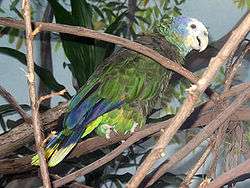Saint Vincent amazon
| Saint Vincent amazon | |
|---|---|
 | |
| Specimen at Botanic Gardens St. Vincent, Kingstown. | |
| Scientific classification | |
| Kingdom: | Animalia |
| Phylum: | Chordata |
| Class: | Aves |
| Order: | Psittaciformes |
| Superfamily: | Psittacoidea |
| Family: | Psittacidae |
| Subfamily: | Arinae |
| Tribe: | Androglossini |
| Genus: | Amazona |
| Species: | A. guildingii |
| Binomial name | |
| Amazona guildingii (Vigors, 1837) | |
The Saint Vincent amazon (Amazona guildingii) also known as Saint Vincent parrot, is a large, approximately 40 cm long, multi-colored amazon parrot with a yellowish white, blue and green head, greenish-bronze upperparts plumage, and violet blue-green wings.
Description
40 cm (16 in) long, mostly green, multi-colored amazon parrot with a yellowish white, blue and green head, greenish-bronze upperparts, grey feet, reddish eye, and violet blue-green wings. Its tail feathers are blue with broad yellow tips. There is a less yellow-brown morph and a less common green morph.[2] It has grey feet and reddish eyes. Both sexes are similar. The young has lighter plumage and brown iris.
Range
The Saint Vincent amazon is endemic to the heavily forested mountains of the Caribbean island of Saint Vincent in the Lesser Antilles. Its diet consists mainly of fruits, nuts, flowers and seeds. The female usually lays one to two eggs.
Conservation
The Nicholas Wildlife Aviary Complex, located within the Saint Vincent (island) maintains a vital captive breeding and conservation program to conserve the St Vincent Parrot.
There is also a small population of St. Vincent parrots at the long-closed Graeme Hall Nature Sanctuary in Barbados. However there has been at least one raid on the parrots in the last few years with one being killed so that in 2010 the owner of the Sanctuary requested the Barbados Government if he could move them to an off-shore Island. After some years of prevarication the Barbados Government still has to make a decision on this. Meanwhile the Sanctuary is suffering from increased poaching and raids, about which the local Police have been reported as not doing anything.
Threats and Status
Hunting for food, trapping for the cage-bird trade and habitat loss were the principal causes of this species's decline. Deforestation has been the result of forestry activities, the expansion of banana cultivation, charcoal production, the loss of nesting-trees felled by trappers seeking young birds for trade, and natural events such as hurricanes and volcanic eruptions (Snyder et al. 2000).
The introduced nine-banded armadillo (Dasypus novemcinctus), undermines large trees causing them to topple, reducing the number of suitable nest trees (Culzac-Wilson 2005).
A cross-country road is planned, funded by the Taiwanese government, which would destroy large areas of suitable habitat and increase deforestation rates (Culzac-Wilson et al. 2003).
The genetic isolation of the separate sub-populations may present further cause for concern.
The small population of captive birds at the Graeme Hall Sanctuary in Barbados is at very high risk. This is due to the lethargy of the Barbados Government in working with the St. Vincent Government and the owner of the Graeme Hall Sanctuary to move the birds to an off-shore island or even back to St. Vincent. Increased raids and poaching at the Sanctuary, the deliberate cutting off of the Sanctuary's water supply, and little or no support from the local Police when raids occur, all mean that this small population is unlikely to survive.
Due to all of these contributing factors, the St. Vincent Parrot is considered Vulnerable on the IUCN Red List of Threatened Species.[1] It is listed on Appendix I and II of CITES.
Gallery
- Front
 Side
Side
References
- 1 2 BirdLife International (2013). "Amazona guildingii". IUCN Red List of Threatened Species. Version 2013.2. International Union for Conservation of Nature. Retrieved 26 November 2013.
- ↑ "Species factsheet: Amazona guildingii". BirdLife International (2008). Retrieved 27 August 2008.
External links
- BirdLife Species Factsheet
- Relocation of Endangered Parrots From Graham Hall Sanctuary Delayed by Barbados Ministry of Environment
| Wikimedia Commons has media related to Amazona guildingii. |

